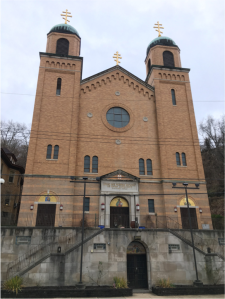By William Horowitz
December 2019
Pittsburgh native Andy Warhol became a household name in the early 1960s as an artist with unmatched celebrity. He was the leader of a new artistic movement called Pop Art that he popularized after moving to New York in 1949. This artistic style challenged traditional perceptions of fine art, focusing on non-glamorous subject material.

Before gaining superstar status, Warhol grew up at 3252 Dawson Street in South Oakland, graduated from Schenley High School, and attended the Carnegie Institute. Warhol’s parents, Julia and Ondrej Warhola, were working class Slovakians and part of a mass-migration of Slavic immigrants that formed a substantial community in Pittsburgh in the 1910s and 1920s. Warhol was baptized as a child and raised as a practicing Byzantine Orthodox Christian. He would remain a member of the church for his entire life, often volunteering at homeless shelters and attending religious services in New York City. As a child, his family attended St. John Chrysostom Byzantine Catholic Church which was built in 1910 to accommodate the growing population of Carpatho-Ruthenian immigrants like the Warhol (originally Warhola) family. The church is an exemplary model of the Eastern Byzantine architectural style and is filled with vibrant depictions of Biblical figures and Eastern Orthodox iconography. The images in the church were some of Warhol’s earliest exposure to art and had a profound influence on his work.

The Warhol Museum on the North Shore of Pittsburgh has many examples of his religious work on display. They all include a combination of traditional imagery, Warhol’s silkscreen techniques, and commercial packaging or advertisements. A prime example is the painting titled Raphael Madonna-$6.99 (1985). Other examples include The Last Supper (1986) or Cologne Cathedral (1985), which both use silkscreen techniques and bright colors reminiscent of Warhol’s famous portraits. These works provide an interesting look into the religious life of one of the most iconic artists of the 20th century as well as immigrant ethnic minorities that shaped Pittsburgh at the beginning of the century.

Further Reading
Andy Warhol Museum, José Carlos Diaz, Miranda Lash, and Patrick Moore. Andy Warhol: Revelation. The Andy Warhol Museum, Pittsburgh, PA, 2019.
Dillenberger, Jane, and Andy Warhol. The Religious Art of Andy Warhol. Continuum, New York, 1998.
“The Window at Bonwit’s.” Andy Warhol, by Arthur C. Danto, Yale University Press, 2009, p. 4.
Thomas, M. “’Revelation’: Religion, Spirituality and Family Run Deep in Andy Warhol’s Art.” Pittsburgh Post-Gazette, 4 Oct. 2019, www.post-gazette.com/ae/art-architecture/2019/10/18/Revelation-exhibition-Andy-Warhol-Museum-2019-Pittsburgh-Byzantine-Catholic/stories/201910200004.
How to Cite
MLA: Horowitz, William. “Raphael Madonna-$6.99.” ReligYinz: Mapping Religious Pittsburgh. University of Pittsburgh, 10 Dec. 2019, religyinz.pitt.edu/raphael-madonna/
APA: Horowitz, William. (2019, December 10). Raphael madonna-$6.99. ReligYinz: Mapping Religious Pittsburgh. https://religyinz.pitt.edu/raphael-madonna/
Chicago: Horowitz, William. “Raphael Madonna-$6.99.” ReligYinz: Mapping Religious Pittsburgh. University of Pittsburgh, 10 December 2019. https://religyinz.pitt.edu/raphael-madonna/
